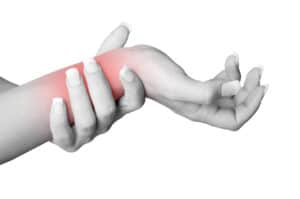
Common symptoms of carpal tunnel syndrome include burning, tingling or numbness in the palm of the hand and along the fingers, especially the thumb, index and middle finger. These feelings may intensify to the point where it becomes difficult to hold small objects or to make a fist. The pain associated with this condition can range from mild-to-severe. As the syndrome progresses, symptoms may be felt during the day when using the hand. People may also experience weakness in the hands, clumsiness, decreased grip strength and difficulty in doing tasks where manual dexterity is required. If left untreated it can lead to muscle damage. Carpal tunnel syndrome may increase gradually with symptoms usually first noticed at night. If left untreated it can lead to muscle damage.
There are many causes and risk factors that increase the chances of getting carpal tunnel syndrome. A wrist dislocation or fracture may create a change in pressure in the carpal tunnel, increasing the chances for median nerve damage. Women are more likely to have this condition because of the smaller carpal tunnel. Obesity is also a common risk factor. Fluid retention, specifically during pregnancy or menopause, can increase the pressure on the median nerve as well. If you have certain medical conditions such as diabetes, rheumatoid arthritis, osteoarthritis, kidney failure, or thyroid disorders, there is an increased risk for carpal tunnel syndrome.
In order to diagnose carpal tunnel syndrome, a physician will start with a physical examination and run a few different tests. These can include an X-ray that can rule out any other wrist pain such as a fracture or arthritis, an electromyogram that evaluates the muscles of the arm and hand, and a nerve conduction study that shocks the median nerve.
There are many ways to treat carpal tunnel syndrome depending on the severity of the condition. Those who have mild symptoms can treat their wrist discomfort and pain by frequently resting their arms, avoiding any strenuous physical activity and movements of the arms, and applying ice packs if there is swelling. If these do not provide relief in weeks, your doctor can provide other options. Wrist splinting can relieve the tingling and numbness, especially at night. Nonsteroidal anti-inflammatory drugs such as ibuprofen provides temporary pain relief. Corticosteroid injections can decrease the swelling and inflammation of the median nerve and have been found to be effective.
Surgery is an option if the carpal tunnel symptoms are severe, extremely painful, and if there is no progress after nonsurgical treatment. Carpal tunnel surgery relieves the pressure on the median nerve by severing the ligament producing the pressure that is irritating the nerve. This can be done by either endoscopic surgery or open surgery.
The risk of carpal tunnel syndrome can be reduced by maintaining a healthy body weight and managing conditions such as diabetes and rheumatoid arthritis that contribute to nerve damage and inflammation. Avoid sleeping on the wrists and maintain good posture, positioning, and grip in everyday tasks to reduce wrist strain. If you perform repetitive tasks at work or at home, take frequent breaks and change your hand positions. When working at a computer, ensure you are using good posture and your wrists are not in a flexed position when you type. You can also do wrist stretching exercises.
For more relief techniques or a proper diagnosis come see our hand specialists, Dr. Hsu.

